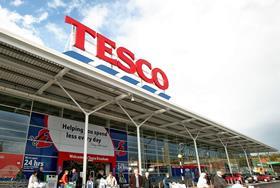
Tesco’s sales figures are returning to full health while Aldi and Lidl’s rapid growth is starting to lose pace.
Tesco registered its fastest sales growth in three years, with year-on-year sales growth of 2.2 per cent in the 12 weeks to 6 November, according to Kantar. This has boosted Tesco’s grocery market share to 28.2 per cent from 27.9 per cent at the same point last year.
The German discounters, meanwhile, are now growing at their slowest rate since 2011. Aldi’s sales rose 10.2 per cent to a 6.1 per cent market share, while Lidl grew by 6.1 per cent to occupy 4.6 per cent of the grocery market.
Fraser McKevitt, head of retail and consumer insight at Kantar Worldpanel, commented: “Tesco’s 2.2 per cent growth is a considerable improvement on the numbers it was delivering this time last year, and indeed in 2014.
“Branded sales did see an increase but most of the gains were made through its own-label products, both at the cheaper and more premium ends of the price spectrum. Tesco’s Farm Brands continue to benefit from sales growth in fruit and vegetables, while the premium Tesco Finest range has grown by 6 per cent in the past 12 weeks, notably in crisps, fresh meat and chilled convenience.
He added: “Much of Tesco’s growth has come from more affluent shoppers returning to the store, and average spend per trip is up by 2.1 pre cent to £20.69.”
Sales growth at Aldi and Lidl, meanwhile, has slowed, but both chains continue to attract new shoppers, aided by continuing store openings. Some 547,000 more shoppers visited Aldi in the 12 weeks to 6 November – a bigger increase than at any other retailer.
Impressive growth was also enjoyed by Iceland, whose sales rose by 8.3 per cent, while Sainsbury’s (-0.7 per cent), Asda (-5 per cent) and Morrisons (-2.4 per cent) all saw their year-on-year sales decline.
When it comes to prices, Kantar predicts that although the cost of groceries has been falling continuously since September 2014 – and on a like-for-like basis goods are still 0.5 per cent cheaper than last year – this represents a significant reduction in the rate of deflation since the summer.
“We’re likely to see prices starting to creep up again in December, unless retailers choose Christmas to unleash a new round of price cuts,” said McKevitt. “Although it’s tempting to link any potential price increases to Brexit and the devaluation of sterling, it’s worth remembering that deflation has been easing since December last year, well before the referendum.”



